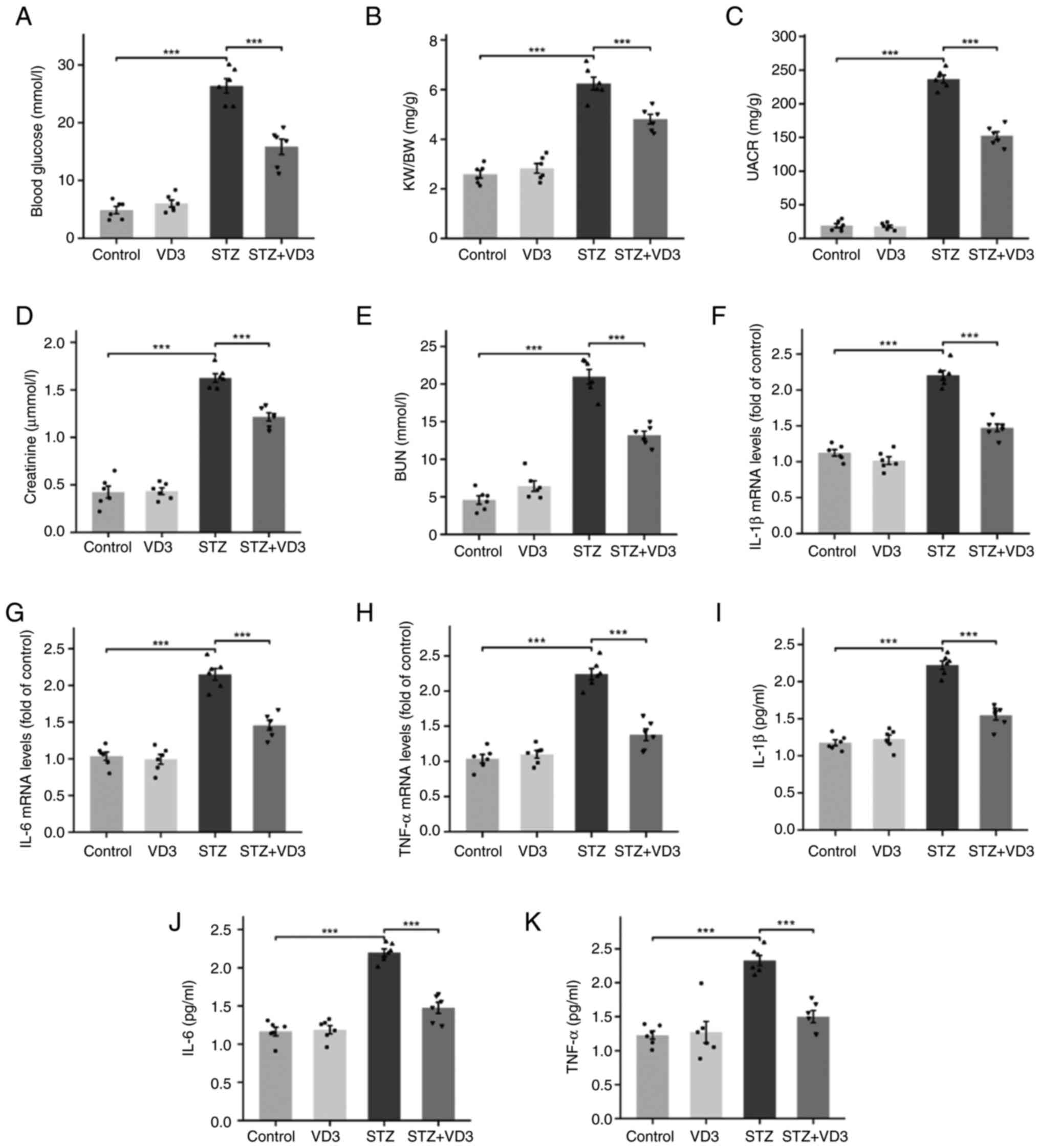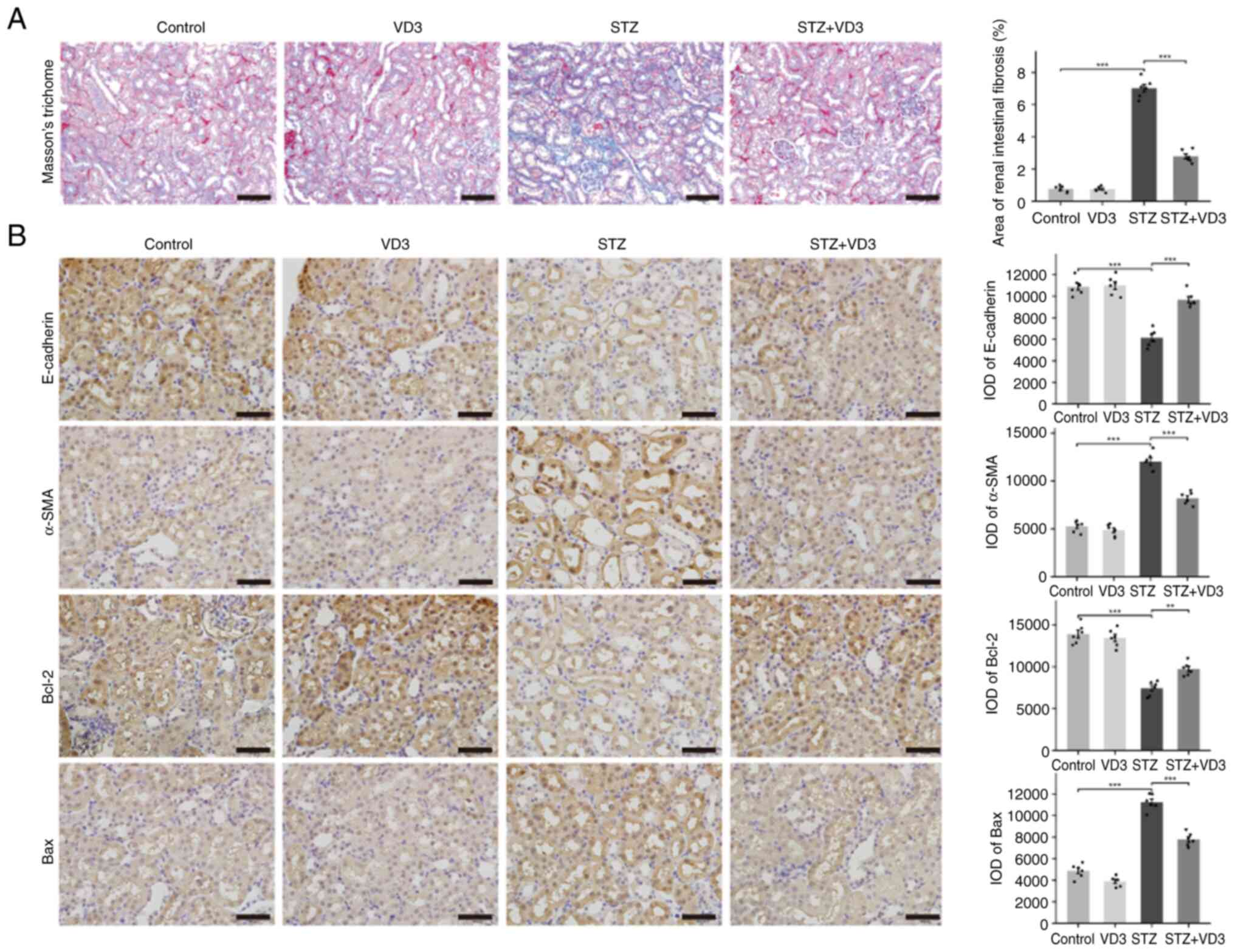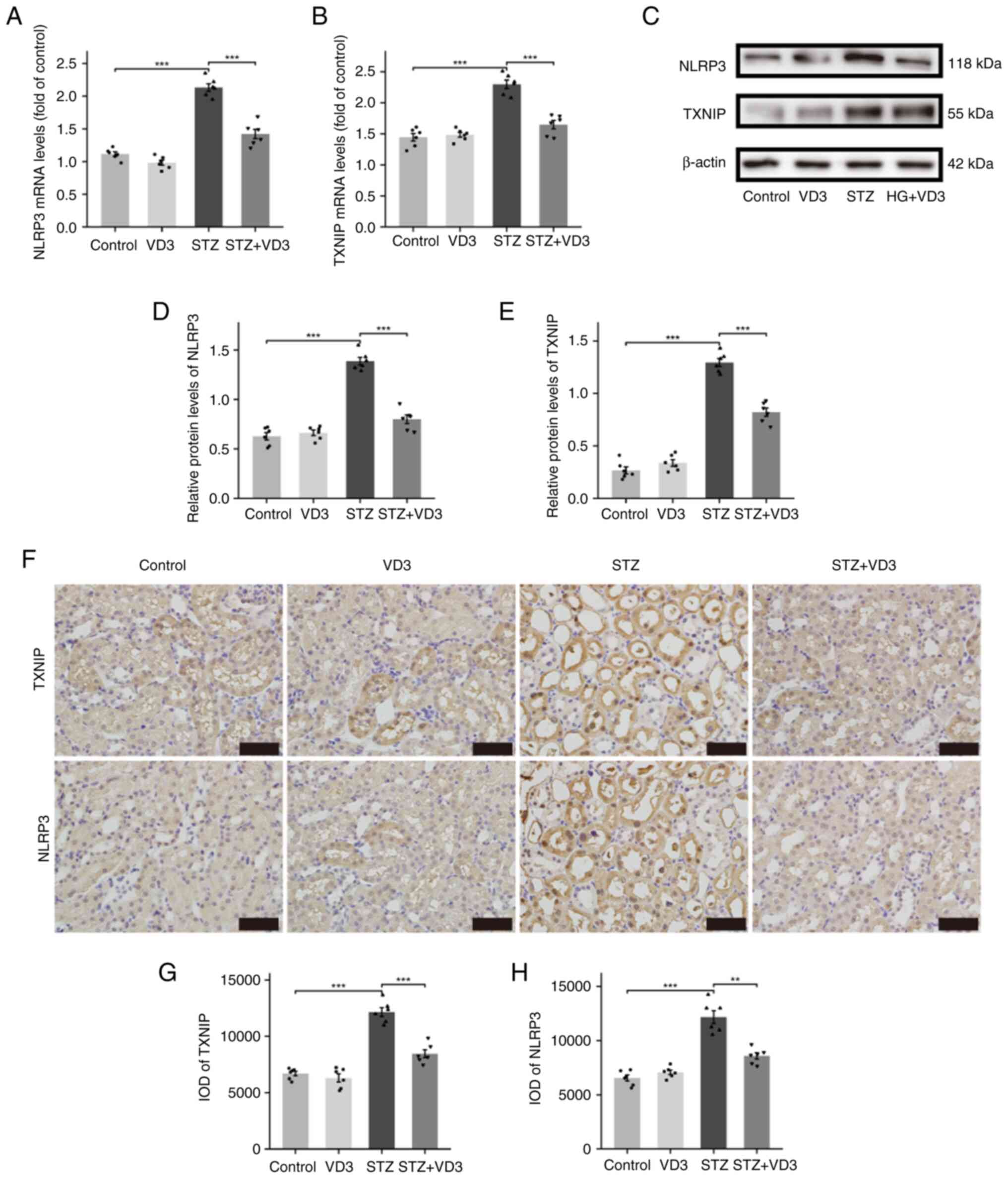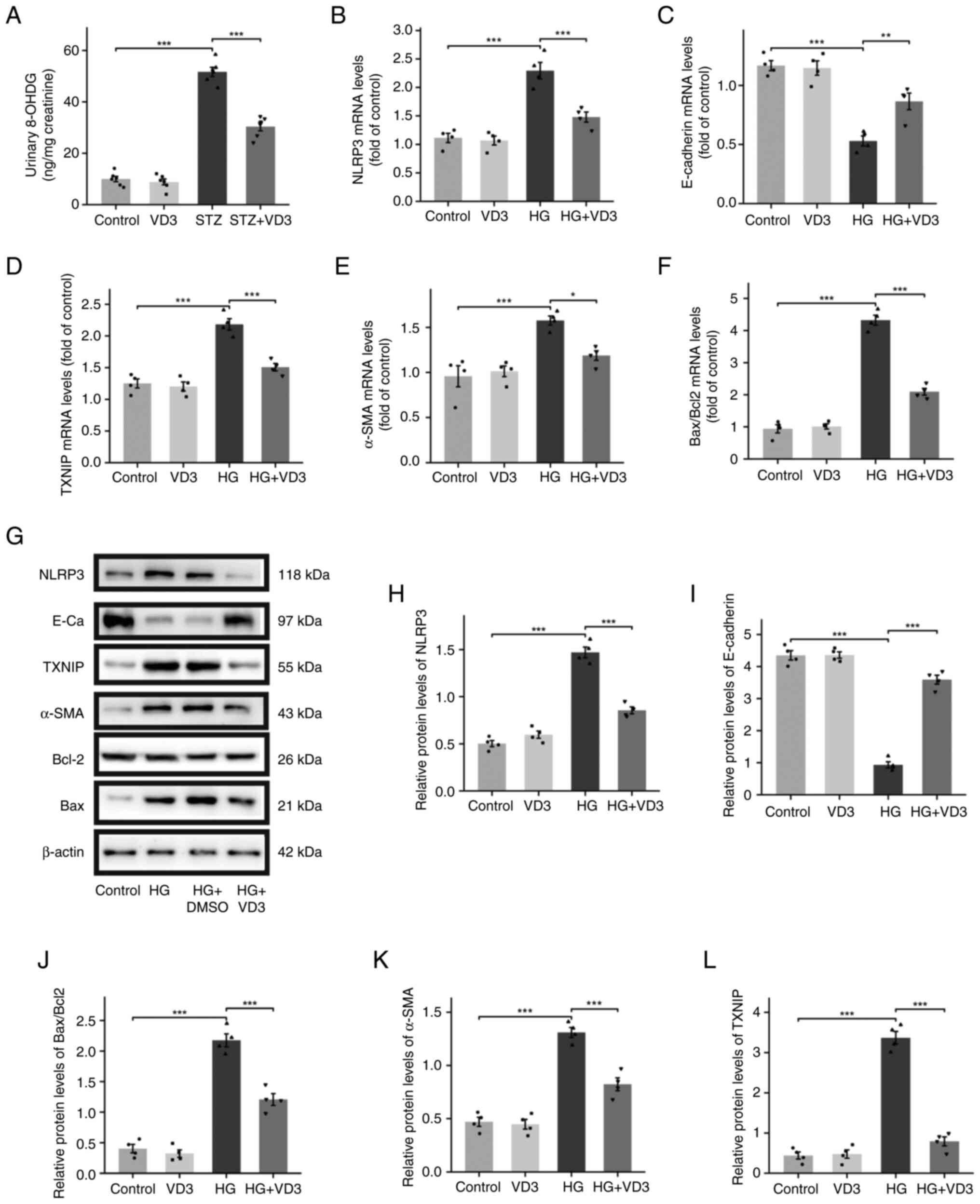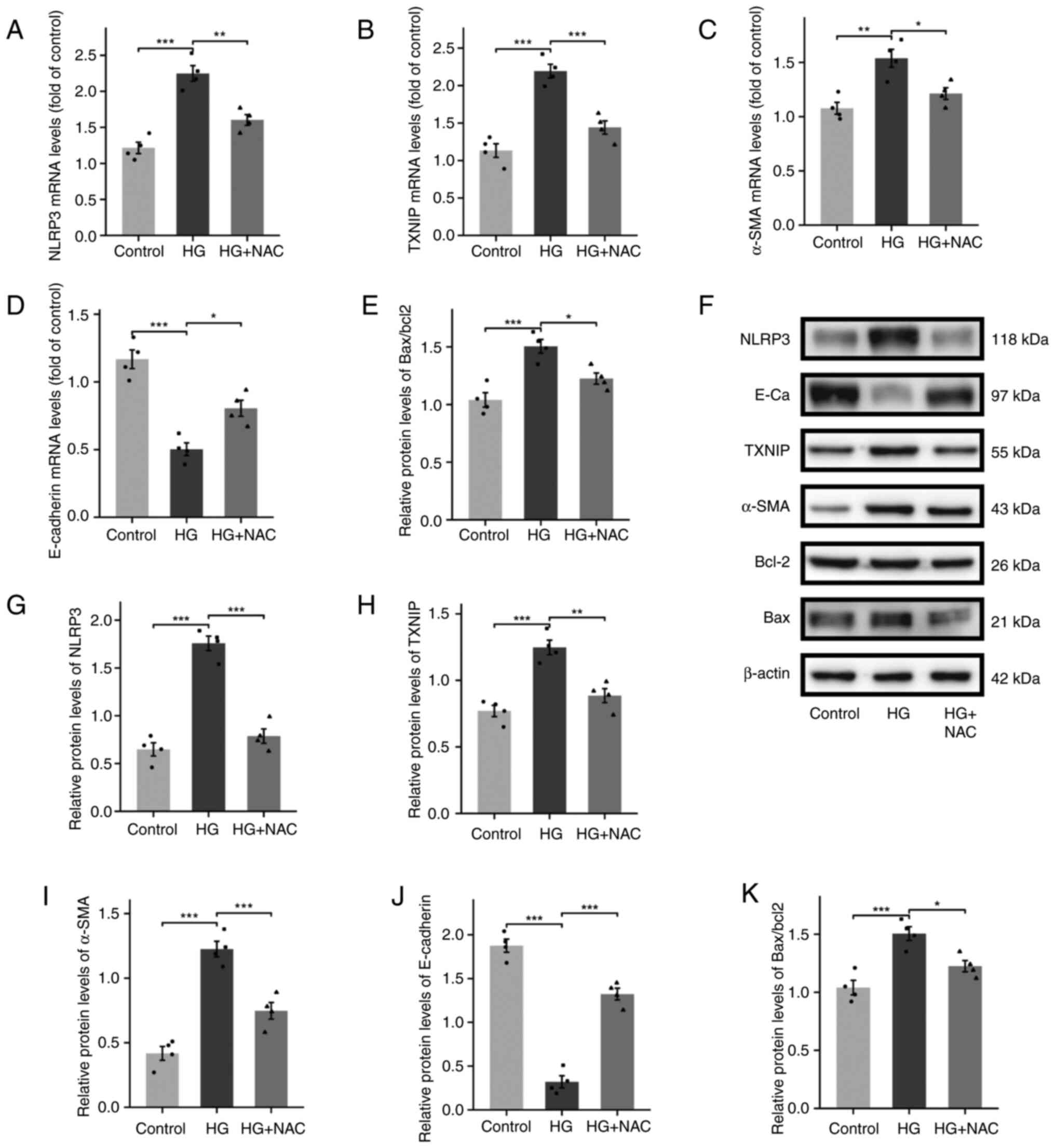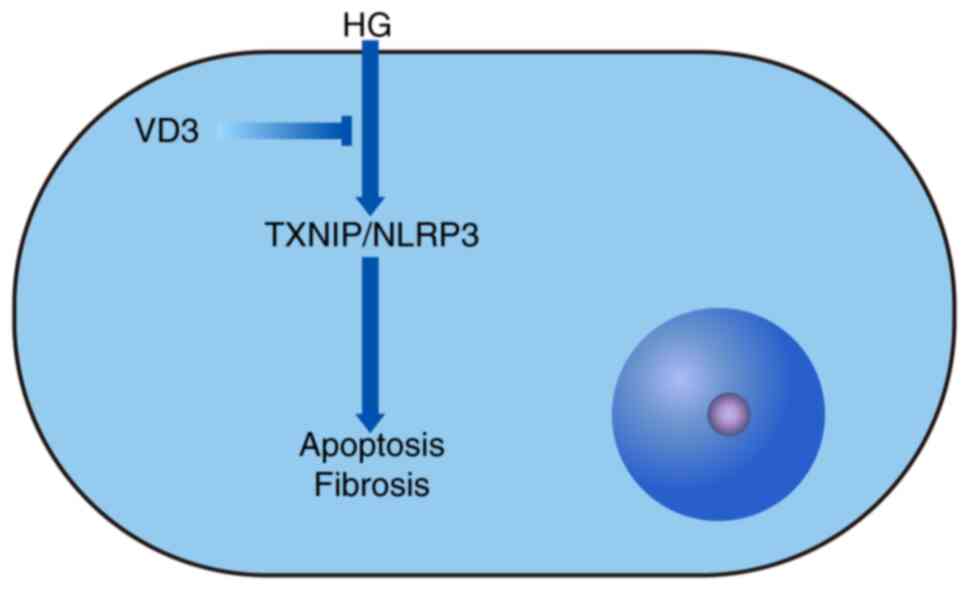Therapeutic potential of vitamin D3 in mitigating high glucose‑induced renal damage: Mechanistic insights into oxidative stress inhibition and TXNIP/NLRP3 signaling pathway blockade
- Authors:
- Published online on: May 9, 2024 https://doi.org/10.3892/etm.2024.12565
- Article Number: 277
-
Copyright: © Li et al. This is an open access article distributed under the terms of Creative Commons Attribution License.
Abstract
Introduction
Diabetes is one of the key factors posing a threat to human health (1). The global prevalence of diabetes is expected to rise notably, with the number of patients projected to increase from 171 million in 2000 to 366 million globally in 2030(2), emphasizing the need for innovative therapeutic strategies. Diabetic nephropathy (DN), as the most common complication of diabetes, leads to chronic kidney and end-stage renal disease (3,4), presenting a challenge in diabetes management. While the primary causes of DN, including renal hemodynamic abnormality and metabolic disorders caused by high blood sugar, are well-recognized (5,6), there remains a lack of effective treatments targeting these underlying mechanisms. The present study aims to address this gap by exploring the potential of vitamin D3 as a novel therapeutic agent in mitigating renal damage in DN, thereby offering a translational perspective to understanding of DN treatment.
In diabetes, elevated blood glucose levels lead to increased generation of reactive oxygen species (ROS) in cells, which serves a crucial role in the development of DN (7,8). ROS can activate the thioredoxin interacting protein (TXNIP/NLRP3 inflammatory pathway, leading to renal fibrosis (9,10). Furthermore, oxidative stress responses aggravate cellular apoptosis by promoting DNA damage within cells (11). Therefore, inhibiting oxidative stress is an important target for treating DN.
1,25-dihydroxyvitamin D3 (1,25(OH)2D3) is the active metabolite of vitamin D and possesses various biological functions such as calcium regulation, pleiotropy, blood pressure control, immune modulation, apoptosis inhibition and anti-angiogenesis (12-15). Additionally, in endothelial cells, vitamin D3 has anti-inflammatory and antioxidant effects (16). Vitamin D3 can protect endothelial cells by decreasing oxidative stress reactions and inhibiting the TXNIP/NLRP3 inflammatory response pathway (9). However, it is unclear whether vitamin D3 has therapeutic effects on renal tubular epithelial cells in DN.
The present study aimed to investigate the effects of vitamin D3 on oxidative stress reactions and the TXNIP/NLRP3 inflammatory response pathway in diabetic mice. Specifically, we sought to determine whether vitamin D3 could alleviate apoptosis and fibrosis in renal tubular epithelial cells, thus offering a potential therapeutic approach for diabetic nephropathy (DN)'.
Materials and methods
Animals
Male C57BL/6J mice (age, 8 weeks; weight, 20-25 g; number, 24) were obtained from the Animal Research Center of Hebei Medical University (Shijiazhuang, Hebei, China). The animals were housed in a specific-pathogen-free facility and maintained at a controlled temperature of 22±2˚C and relative humidity of 50±10%. They were subjected to a 12/12-h light/dark cycle, with ad libitum access to food and water. The animal facility used in the study was certified by the International Association for Assessment and Accreditation of Laboratory Animal Care and all animal protocols used in this study were approved by the Experimental Animal Welfare Ethics Committee of Hebei Medical University (2022-021).
Mice were randomly divided into groups and intraperitoneally injected with 60 mg/kg streptozotocin (STZ). Mice were classified as diabetic if their blood glucose levels exceeded 16.7 mmol/l 48 h post-streptozotocin (STZ) administration. The glucose measurements were carried out using a standard glucometer (LifeScan) following a 12 h fasting period to minimize dietary impact. Blood samples were obtained via non-invasive tail vein sampling, and glucose levels were measured at the 48-h mark. Each mouse's glucose level was measured twice to ensure accuracy, with the average value being recorded. All procedures were conducted under consistent conditions to ensure the reliability and reproducibility of the experimental outcomes. Age-matched control mice received an equivalent amount of sodium citrate instead of STZ. The mice were randomly divided into four groups (n=6/group): i) Normal control (NC), mice were injected with sodium citrate and received intramuscular injection of DMSO at a concentration of 10%, dissolved in PBS; ii) NC + vitamin D3 (NC + VD), mice received sodium citrate and intramuscular injection of 233.3 U/kg body weight/week calcitriol (Shanghai Titan Technology Co., Ltd.) in DMSO at a concentration of 10%, dissolved in PBS. This treatment commenced 4 weeks following diabetes induction and continued for 6 months; iii) type 1 diabetes group (T1D), STZ-induced diabetic mice received intramuscular injection of DMSO at a concentration of 10%, dissolved in PBS; iv) DM+VD, STZ-induced diabetic mice received intramuscular injections of calcitriol dissolved in 10% DMSO in PBS at a dose of 233.3 U/kg body weight/week, starting from 4 weeks after diabetes induction for 6 months.
In consideration of the solvent properties required, DMSO was used based on its well-established solubility properties and widespread use as a solvent in similar experimental settings (17,18). This concentration was chosen to ensure the adequate solubility of the compounds under investigation, while minimizing potential adverse effects associated with higher concentrations. Preliminary experiments supported the efficacy and safety of this concentration, reinforcing its suitability (data not shown). Other studies corroborate the safe administration of 10% DMSO, aligning with the present findings and supporting the selection of this concentration (17,18).
The 6-month analysis period was selected based on previous literature (9). This timeframe has been shown to be optimal for evaluating the therapeutic impact of vitamin D3 on the progression of DN, allowing comprehensive assessment of disease dynamics and treatment efficacy (9).
Due to the clinical symptoms of polydipsia and polyuria in diabetic mice, adequate feed and water was provided and increase the frequency of bedding replacement. Health and behavior of the animals was monitored 2-3 times/week.
No animals were found dead. After the model was established, collect 24-h urine samples and blood specimens, and then conduct biochemical indicator tests. At the end of the experimental period, the mice were euthanized by inhalation anesthesia with a high dose of isoflurane. For euthanasia, anesthesia was induced at a low concentration (1.0-1.5%) of isoflurane, followed by high concentration (5%) for 3 min, causing the animal to lose consciousness. Cardiac arrest and cessation of breathing were used for determining animal death.
Histology
Following 24 weeks of treatment, kidneys were isolated and fixed at room temperature) in 4% paraformaldehyde for 24 h, followed by gradual dehydration. The kidney tissues were embedded in paraffin and cut into 4-µm sections. Masson's trichrome staining was performed using the MARC SOP method and the specimens were imaged using an Olympus inverted microscope (Olympus Corporation; cat. no. BX51).
Cell culture
HK-2 cells (American Type Culture Collection) were cultured in DMEM-F12 (Gibco; Thermo Fisher Scientific, Inc.) containing 5% fetal bovine serum. At specified time points, HK-2 cells were stimulated with normal glucose (5.6 mM), normal glucose + mannitol (24.4 mM), high glucose (30 mM glucose), high glucose + 50 nM vitamin D3) and high glucose + 10 nM NAC.
ELISA
Protein was extracted from kidney tissue and HK-2 cells. The levels of pro-inflammatory cytokines (IL-1β, IL-6, TNF-α) were determined using ELISA kits (R&D Systems) according to the manufacturer's instructions. Urine samples were centrifuged (4˚C) at 377.3 g. for 10 min to remove particulates. The levels of 8-hydroxy-2'-deoxyguanosine (8-OHDG) in urine were measured using a competitive ELISA kit (Nanjing Jiancheng Bioengineering Institute).
Immunohistochemistry
Kidney specimens were fixed in 4% paraformaldehyde and embedded in paraffin as aforementioned. Kidney sections (0.4 µm) were immunostained using the PV kit (ZS-GB BIO cat. no. PV-6000) according to the manufacturer's instructions. Primary antibodies against TXNIP (1/200;ab188865;Abcam), NLRP3 (1/500;68102-1-Ig;Proteintech.), Bax (1/200;50599-2-Ig;Proteintech.), Bcl2 (1/200; ab32124;Abcam), α-smooth muscle actin (18:200;ab7817; Abcam), and E-cadherin (1/300;20874-1-AP;Proteintech) were used for staining (4˚C,12 h). Positive staining was evaluated using Image-Pro Plus 6.0 software (Media Cybernetics, Inc.) for quantitative analysis Specimens were imaged using an Olympus inverted light microscope (Olympus Corporation; cat. no. BX51; light; 400X).
Protein extraction and western blotting
Protein was extracted from renal cortex tissue and HK-2 cells using lysis buffer (MilliporeSigma) according to standard procedures. Nuclear and cytoplasmic proteins were extracted from HK-2 cells using a commercial nuclear extraction kit (Active Motif, Inc.). Proteins (50 µg/lane) were separated by SDS-PAGE and transferred onto PVDF membranes. The membranes were incubated overnight at 4˚C with primary antibodies against TXNIP (MBL International Co.), NLRP3 (Santa Cruz Biotechnology, Inc.), Bax (Cell Signaling Technology, Inc.), Bcl2 (Cell Signaling Technology, Inc.), α-SMA (Abcam) and E-cadherin (Abcam). After incubation with goat anti-rabbit or mouse IgG horseradish peroxidase-conjugated secondary antibodies, the membranes were scanned using the Odyssey Fc system (LI-COR Biosciences). Density analysis was performed using ImageJ software (National Institutes of Health).
Reverse transcription-quantitative (RT-q)PCR
Total RNA and cDNA were prepared from kidney tissue and HK-2 cells using TRIzol reagent (Invitrogen; Thermo Fisher Scientific, Inc.) and RNA PCR kit (Takara Bio Inc.) according to the manufacturer's instructions. The primers sequences are listed in Table SI. The PCR amplification conditions were as follows: Initial denaturation at 95˚C for 10 min, followed by 40 cycles at 95˚C for 15 sec and 60˚C for 60 sec. Relative mRNA levels of IL-1β, IL-6, TNF-α, TXNIP, NLRP3, Bax, Bcl2, α-SMA and E-cadherin were determined using the SYBR Green PCR master mix (Applied Biosystems; cat. no. 4309155) and reactions were performed on an Agilent MX3000P QPCR system (Agilent Technologies, Inc.). The relative changes in gene expression were calculated using the 2-ΔΔCq method and all experiments were performed at least three times.
Statistical analysis
Data are presented as the mean ± SD. Continuous variable data that exhibited normality and homogeneity of variance were analyzed using one-way ANOVA followed by Tukey's HSD and Games-Howell post hoc test. Otherwise, Mann-Whitney U test was applied. Statistical analysis was conducted using SPSS Statistics 21.0 (IBM Corp.). P<0.05 was considered to indicate a statistically significant difference.
Results
Vitamin D3 improves renal function damage and inflammatory response in diabetic mice
Blood glucose levels in diabetic mice were significantly higher than in non-diabetic mice (Fig. 1A). Treatment with vitamin D3 significantly decreased the kidney-to-body weight ratio, urinary albumin-to-creatinine ratio, serum creatinine and blood urea nitrogen levels in diabetic mice (Fig. 1B-E). To evaluate the intensity of renal inflammation, RT-qPCR and ELISA were used to detect expression levels of pro-inflammatory factors such as IL-1β, IL-6 and TNF-α (Fig. 1F-K). Compared with the control, the expression of pro-inflammatory factors was elevated in diabetic mice but attenuated after treatment with vitamin D3. These findings suggest that vitamin D3 improved renal function damage and inflammatory response in diabetic mice.
Vitamin D3 inhibits tubulointerstitial fibrosis and cell apoptosis in diabetic mice
Tubulointerstitial fibrosis and cell apoptosis are key features in DN. To investigate whether vitamin D3 can improve reverse fibrosis and cell apoptosis, Masson's trichrome staining was performed on kidney sections (Fig. 2A). Compared with the control group, diabetic mice exhibited severe tubulointerstitial fibrosis, which was restored to a similar state as the control group following treatment with vitamin D3. Immunohistochemistry was used to detect expression of E-cadherin, α-SMA, Bcl2 and Bax (Fig. 2B). The results indicated a significant increase in the expression of the fibrosis marker α-SMA in diabetic mice, which decreased following treatment with vitamin D3. E-cadherin demonstrated a significant decrease in its expression in diabetic mice, with an increase following vitamin D3 treatment. Similarly, the Bax/Bcl-2 ratio, an indicator of apoptosis, showed a similar trend in diabetic mice. These findings demonstrated that vitamin D3 not only alleviated tubulointerstitial fibrosis in diabetic mice but also inhibited apoptosis in renal tubular epithelial cells.
TXNIP/NLRP3 pathway mediates the effects of vitamin D3 in renal tubules
TXNIP/NLRP3 pathway is known to mediate endogenous inflammatory responses. Expression of TXNIP and NLRP3 significantly decreased following treatment with vitamin D3 in diabetic mice (Fig. 3A-F). Therefore, it was hypothesized that in DN, vitamin D3 exerted its effects through the TXNIP/NLRP3 inflammatory pathway.
Vitamin D3 alleviates fibrosis and apoptosis in HK-2 cells by inhibiting oxidative stress and the TXNIP/NLRP3 inflammatory pathway. 8-OHDG is a commonly used marker for oxidative stress. ELISA was used to measure the levels of 8-OHDG in mouse urine (Fig. 4A). The results showed a significant increase in 8-OHDG levels in the urine of diabetic mice, which was not observed in diabetic mice treated with vitamin D3. HK-2 cells were treated with vitamin D3 under different glucose concentrations before RT-qPCR experiments. Following 48 h incubation in HG medium, gene expression of TXNIP and NLRP3 was significantly increased in HK-2 cells. However, there was a significant decrease in expression of the fibrosis marker E-cadherin (Fig. 4C, G and I). The expression of other fibrosis markers and apoptosis factors generally increased. The addition of vitamin D3 to HG medium notably prevented the upregulation of TXNIP and NLRP3 gene expression and decreased overall fibrosis and apoptosis in the cells (Fig. 4B-F). Immunoblotting experiments with protein extract confirmed the trend observed in the RT-qPCR results, particularly the decrease in E-cadherin expression under HG conditions (Fig. 4G-L). Taken together, these findings suggested that vitamin D3 alleviates fibrosis and cell apoptosis in HK-2 cells by inhibiting oxidative stress and the TXNIP/NLRP3 inflammatory pathway.
Vitamin D3 mediates the TXNIP/NLRP3 inflammatory pathway by inhibiting oxidative stress
To confirm that vitamin D3 inhibits the TXNIP/NLRP3 inflammatory pathway by suppressing oxidative stress, HK-2 cells were cultured with the oxidative stress inhibitor NAC under different glucose concentrations. NAC-mediated inhibition of intracellular oxidative stress effectively suppressed the TXNIP/NLRP3 inflammatory pathway at both mRNA and protein levels, thereby alleviating fibrosis and apoptosis in HK-2 cells (Fig. 5A-K).
Discussion
In recent years, there has been extensive discussion regarding the functions of vitamin D3. In addition to its role in calcium and bone homeostasis, vitamin D3 also serves a role in anti-inflammatory and oxidative stress inhibition (19). A wealth of evidence suggests that vitamin D3 deficiency can lead to various types of inflammatory disease, such as transplant rejection and inflammatory bowel and cardiovascular diseases (20). Therefore, understanding the anti-inflammatory pathways of vitamin D3 may lead to identification of potential targets for treating these diseases.
The relationship between vitamin D3 and complications of diabetes has become a research hotspot in recent years (21-23). Here, vitamin D3 had a protective effect in DN. Treatment with vitamin D3 improved renal function and decreased inflammation in diabetic mice. Additionally, it partially reversed fibrosis and apoptosis in renal tubular epithelial cells. Activation of the TXNIP/NLRP3 inflammatory pathway was primarily due to HG-induced oxidative stress. Vitamin D3 was able to downregulate expression of TXNIP by inhibiting oxidative stress, thereby blocking the activation of NLRP3 and decreasing the inflammatory response, protecting renal tissue and preventing fibrosis and apoptosis in renal tubular epithelial cells. Additionally, the potential role of vitamin D3 in modulating blood glucose levels suggests involvement in several key molecular pathways. Specifically, vitamin D3 may exert direct effects on pancreatic β cells, promoting insulin secretion via modulation of calcium homeostasis and β cell gene expression (24). Future research will further elucidate these pathways, exploring their interactions and potential for therapeutic targeting to manage hyperglycemia and associated metabolic disorders.
Increased expression of TXNIP in diabetes can lead to pathological damage such as glomerulosclerosis, interstitial fibrosis, cell apoptosis and inflammation (25-28). TXNIP, as an oxidative stress sensor, serves a critical role in the regulation of NLRP3 inflammasome activation. Under normal conditions, TXNIP is bound to thioredoxin (TRX), which inhibits its function. However, under oxidative stress, TRX dissociates from TXNIP, leading to activation of the NLRP3 inflammasome and the production of inflammatory cytokines (29). By understanding the regulation of NLRP3 inflammasome activation, specific inhibitors may be rationally designed for the treatment and prevention of numerous types of immune- or metabolic-based disease (30,31). HG induces production of ROS, which in turn activates oxidative stress responses (17,32,33). Activation of oxidative stress responses can convert the function of sensitive TXNIP from a thioredoxin inhibitor to an activator of the NLRP3 inflammasome (34). In the present study, there was an increase in the expression of 8-OHDG, a marker of oxidative stress, after HG stimulation of HK-2 cells. Therefore, it was hypothesized that vitamin D3 exerts its protective effects on the kidney by inhibiting oxidative stress and blocking the TXNIP/NLRP3 inflammatory pathway. To test this hypothesis, NAC was added to HG-treated HK-2 cells. NAC decreased expression of TXNIP and NLRP3, consistent with the effects of vitamin D3. Thus, the present study confirmed that vitamin D3 blocks the TXNIP/NLRP3 pathway by inhibiting oxidative stress. The present study investigated the mechanisms by which vitamin D3 may alleviate DN by inhibiting oxidative stress and the TXNIP/NLRP3 inflammatory pathway in renal tubular epithelial cells, offering new insights for potential therapeutic intervention.
The present study aimed to investigate the impact of nuclear and cytoplasmic components on the outcomes. However, upon analysis, no significant differences in protein expression between the nuclear and cytoplasmic fractions extracted from HK-2 cells were observed. Therefore, these observations were integrated into a unified analysis to provide a coherent and comprehensive discussion of the overall protein expression profile.
In conclusion, the present study demonstrated that vitamin D3 has a protective effect on renal tubular epithelial cells in diabetic mice. It alleviated interstitial fibrosis and cell apoptosis in renal tubules. Additionally, this protective effect is due to the ability of vitamin D3 to inhibit oxidative stress in renal tubules, thereby blocking the TXNIP/NLRP3 pathway.
However, it is important to recognize the limitations of the present study. The present findings are based on a specific animal model and focused primarily on the TXNIP/NLRP3 inflammatory pathway, which may limit the generalizability of results to other models or human subjects. Furthermore, the present study did not explore the broader impact of vitamin D3 on systemic glucose homeostasis. To address these limitations, future studies should investigate the mechanistic pathways by which vitamin D3 influences glucose homeostasis, alongside its renal protective effects.
The present study not only confirms that vitamin D3 can protect renal tubular epithelial cells in DN by inhibiting oxidative stress and blocking the TXNIP/NLRP3 inflammatory pathway but also highlights its potential as a novel therapeutic approach. These findings may facilitate application of vitamin D3 in the clinical management of DN, suggesting that it could be a valuable addition to current treatment strategies. Future clinical trials are warranted to explore the efficacy of vitamin D3 in improving outcomes for patients with diabetic kidney disease, thereby translating the present findings from the laboratory to the clinic (Fig. 6).
Supplementary Material
Primer sequences.
Acknowledgements
Not applicable.
Funding
Funding: The present study was supported by Hebei Province Medical Science Research Key Project Plan (grant no. 20180200).
Availability of data and materials
The data generated in the present study may be requested from the corresponding author.
Authors' contributions
GL performed experiments and wrote the manuscript. SH and TL searched the literature and analyzed the data. NZ and TL searched the literature and revised the manuscript. NZ designed the experiments and revised the manuscript. All authors have read and approved the final manuscript. NZ and GL confirm the authenticity of all the raw data.
Ethics approval and consent to participate
The present study was approved (approval no. 2016043) by the Ethics Committee of the Hebei General Hospital (Shijiazhuang, China).
Patient consent for publication
Not applicable.
Competing interests
The authors declare that they have no competing interests.
References
|
Diabetes Control and Complications Trial/Epidemiology of Diabetes Interventions and Complications (DCCT/EDIC) Research Group. Nathan DM, Zinman B, Cleary PA, Backlund JC, Genuth S, Miller R and Orchard TJ: Modern-day clinical course of type 1 diabetes mellitus after 30 years' duration: The diabetes control and complications trial/epidemiology of diabetes interventions and complications and pittsburgh epidemiology of diabetes complications experience (1983-2005). Arch Intern Med. 169:1307–1316. 2009.PubMed/NCBI View Article : Google Scholar | |
|
Wild S, Roglic G, Green A, Sicree R and King H: Global prevalence of diabetes: Estimates for the year 2000 and projections for 2030. Diabetes Care. 27:1047–1053. 2004.PubMed/NCBI View Article : Google Scholar | |
|
Collins AJ, Foley RN, Chavers B, Gilbertson D, Herzog C, Ishani A, Johansen K, Kasiske BL, Kutner N, Liu JN, et al: US renal data system 2013 annual data report. Am J Kidney Dis. 63 (1 Suppl)(A7)2014.PubMed/NCBI View Article : Google Scholar | |
|
Paneni F, Beckman JA, Creager MA and Cosentino F: Diabetes and vascular disease: pathophysiology, clinical consequences, and medical therapy: Part I. Eur Heart J. 34:2436–2443. 2013.PubMed/NCBI View Article : Google Scholar | |
|
Gall MA, Rossing P, Skøtt P, Damsbo P, Vaag A, Bech K, Dejgaard A, Lauritzen M, Lauritzen E, Hougaard P, et al: Prevalence of micro- and macroalbuminuria, arterial hypertension, retinopathy and large vessel disease in European type 2 (non-insulin-dependent) diabetic patients. Diabetologia. 34:655–661. 1991.PubMed/NCBI View Article : Google Scholar | |
|
Remuzzi G, Benigni A and Remuzzi A: Mechanisms of progression and regression of renal lesions of chronic nephropathies and diabetes. J Clin Invest. 116:288–296. 2006.PubMed/NCBI View Article : Google Scholar | |
|
Baynes JW and Thorpe SR: Role of oxidative stress in diabetic complications: A new perspective on an old paradigm. Diabetes. 48:1–9. 1999.PubMed/NCBI View Article : Google Scholar | |
|
Ceriello A, Morocutti A, Mercuri F, Quagliaro L, Moro M, Damante G and Viberti GC: Defective intracellular antioxidant enzyme production in type 1 diabetic patients with nephropathy. Diabetes. 49:2170–2177. 2000.PubMed/NCBI View Article : Google Scholar | |
|
Lu L, Lu Q, Chen W, Li JW, Li CX and Zheng Z: Vitamin D3 protects against diabetic retinopathy by inhibiting high-glucose-induced activation of the ROS/TXNIP/NLRP3 inflammasome pathway. J Diabetes Res. 2018(8193523)2018.PubMed/NCBI View Article : Google Scholar | |
|
Simon AR, Rai U, Fanburg BL and Cochran BH: Activation of the JAK-STAT pathway by reactive oxygen species. Am J Physiol. 275:C1640–C1652. 1998.PubMed/NCBI View Article : Google Scholar | |
|
Kang BPS, Frencher S, Reddy V, Kessler A, Malhotra A and Meggs LG: High glucose promotes mesangial cell apoptosis by oxidant-dependent mechanism. Am J Physiol Renal Physiol. 284:F455–F466. 2003.PubMed/NCBI View Article : Google Scholar | |
|
Zhu XJ, Wu SH and Guo HC: Active vitamin D and vitamin D receptor help prevent high glucose induced oxidative stress of renal tubular cells via AKT/UCP2 signaling pathway. Biomed Res Int. 2019(9013904)2019.PubMed/NCBI View Article : Google Scholar | |
|
Zehnder D, Bland R, Williams MC, McNinch RW, Howie AJ, Stewart PM and Hewison M: Extrarenal expression of 25-hydroxyvitamin d(3)-1 alpha-hydroxylase. J Clin Endocrinol Metab. 86:888–894. 2001.PubMed/NCBI View Article : Google Scholar | |
|
Plum LA and DeLuca HF: Vitamin D, disease and therapeutic opportunities. Nat Rev Drug Discov. 9:941–955. 2010.PubMed/NCBI View Article : Google Scholar | |
|
Prietl B, Treiber G, Pieber TR and Amrein K: Vitamin D and immune function. Nutrients. 5:2502–2521. 2013.PubMed/NCBI View Article : Google Scholar | |
|
Chagas CE, Borges MC, Martini LA and Rogero MM: Focus on vitamin D, inflammation and type 2 diabetes. Nutrients. 4:52–67. 2012.PubMed/NCBI View Article : Google Scholar | |
|
Wei H, Bu R, Yang QH, Jia J, Li T, Wang QP and Chen YJ: Exendin-4 protects against hyperglycemia-induced cardiomyocyte pyroptosis via the AMPK-TXNIP pathway. J Diabetes Res. 2019(8905917)2019.PubMed/NCBI View Article : Google Scholar | |
|
Yates AG, Weglinski CM, Ying Y, Dunstan IK, Strekalova T and Anthony DC: Nafamostat reduces systemic inflammation in TLR7-mediated virus-like illness. J Neuroinflammation. 19(8)2022.PubMed/NCBI View Article : Google Scholar | |
|
Hewison M: Vitamin D and the immune system: New perspectives on an old theme. Rheum Dis Clin North Am. 38:125–139. 2012.PubMed/NCBI View Article : Google Scholar | |
|
Guillot X, Semerano L, Saidenberg-Kermanac'h N, Falgarone G and Boissier MC: Vitamin D and inflammation. Joint Bone Spine. 77:552–557. 2010.PubMed/NCBI View Article : Google Scholar | |
|
Aksoy H, Akçay F, Kurtul N, Baykal O and Avci B: Serum 1,25 dihydroxy vitamin D (1,25(OH)2D3), 25 hydroxy vitamin D (25(OH)D) and parathormone levels in diabetic retinopathy. Clin Biochem. 33:47–51. 2000.PubMed/NCBI View Article : Google Scholar | |
|
Kaur H, Donaghue KC, Chan AK, Benitez-Aguirre P, Hing S, Lloyd M, Cusumano J, Pryke A and Craig ME: Vitamin D deficiency is associated with retinopathy in children and adolescents with type 1 diabetes. Diabetes Care. 34:1400–1402. 2011.PubMed/NCBI View Article : Google Scholar | |
|
Prabhu RA and Saraf K: Vitamin D in diabetic nephropathy. J Postgrad Med. 64:5–6. 2018.PubMed/NCBI View Article : Google Scholar | |
|
Cheng Q, Li YC, Boucher BJ and Leung PS: A novel role for vitamin D: Modulation of expression and function of the local renin-angiotensin system in mouse pancreatic islets. Diabetologia. 54:2077–2081. 2011.PubMed/NCBI View Article : Google Scholar | |
|
Shah A, Xia L, Masson EA, Gui C, Momen A, Shikatani EA, Husain M, Quaggin S, John R and Fantus IG: Thioredoxin-interacting protein deficiency protects against diabetic nephropathy. J Am Soc Nephrol. 26:2963–2977. 2015.PubMed/NCBI View Article : Google Scholar | |
|
Shi Y, Ren Y, Zhao L, Du C, Wang Y, Zhang Y, Li Y, Zhao S and Duan H: Knockdown of thioredoxin interacting protein attenuates high glucose-induced apoptosis and activation of ASK1 in mouse mesangial cells. FEBS Lett. 585:1789–1795. 2011.PubMed/NCBI View Article : Google Scholar | |
|
Ha H, Hwang IA, Park JH and Lee HB: Role of reactive oxygen species in the pathogenesis of diabetic nephropathy. Diabetes Res Clin Pract. 82 (Suppl 1):S42–S45. 2008.PubMed/NCBI View Article : Google Scholar | |
|
Chen N, Song S, Yang Z, Wu M, Mu L, Zhou T and Shi YH: ChREBP deficiency alleviates apoptosis by inhibiting TXNIP/oxidative stress in diabetic nephropathy. J Diabetes Complications. 35(108050)2021.PubMed/NCBI View Article : Google Scholar | |
|
Susztak K, Raff AC, Schiffer M and Böttinger EP: Glucose-induced reactive oxygen species cause apoptosis of podocytes and podocyte depletion at the onset of diabetic nephropathy. Diabetes. 55:225–233. 2006.PubMed/NCBI | |
|
Ortega MA, De Leon-Oliva D, García-Montero C, Fraile-Martinez O, Boaru DL, de Castro AV, Saez MA, Lopez-Gonzalez L, Bujan J, Alvarez-Mon MA, et al: Reframing the link between metabolism and NLRP3 inflammasome: Therapeutic opportunities. Front Immunol. 14(1232629)2023.PubMed/NCBI View Article : Google Scholar | |
|
Fraile-Martinez O, García-Montero C, Pekarek L, Saz JV, Álvarez-Mon MÁ, Barrena-Blázquez S, García-Honduvilla N, Buján J, Asúnsolo Á, Coca S, et al: Decreased survival in patients with pancreatic cancer may be associated with an increase in histopathological expression of inflammasome marker NLRP3. Histol Histopathol. 39:35–40. 2024.PubMed/NCBI View Article : Google Scholar | |
|
Zheng Z, Chen HB, Ke GJ, Fan Y, Zou HD, Sun XD, Gu Q, Xu X and Ho PCP: Protective effect of perindopril on diabetic retinopathy is associated with decreased vascular endothelial growth factor-to-pigment epithelium-derived factor ratio: Involvement of a mitochondria-reactive oxygen species pathway. Diabetes. 58:954–964. 2009.PubMed/NCBI View Article : Google Scholar | |
|
Zheng Z, Chen H, Wang H, Ke B, Zheng B, Li Q, Li P, Su L, Gu Q and Xu X: Improvement of retinal vascular injury in diabetic rats by statins is associated with the inhibition of mitochondrial reactive oxygen species pathway mediated by peroxisome proliferator-activated receptor gamma coactivator 1alpha. Diabetes. 59:2315–2325. 2010.PubMed/NCBI View Article : Google Scholar | |
|
Schroder K, Zhou RB and Tschopp J: The NLRP3 inflammasome: A sensor for metabolic danger? Science. 327:296–300. 2010.PubMed/NCBI View Article : Google Scholar |



